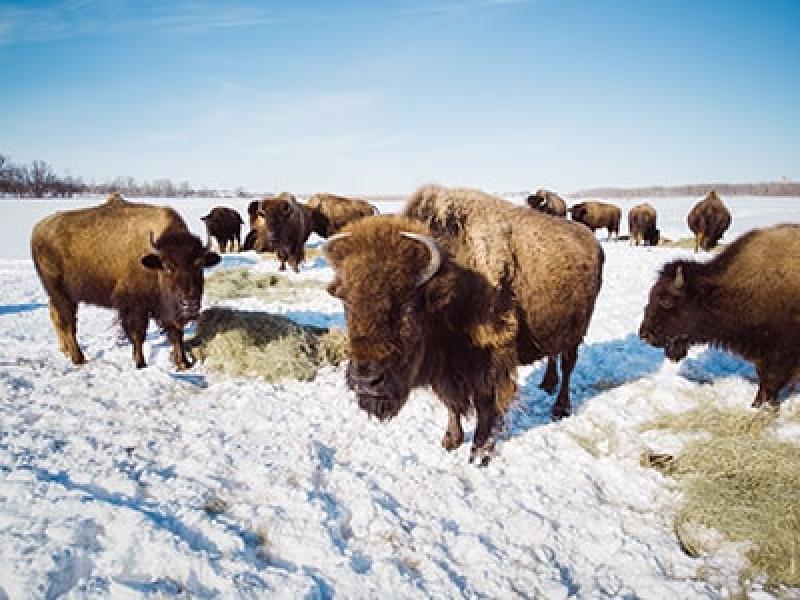
Winnipeg's FortWhyte Alive is a green space spanning 660 acres, housing multiple buildings and hosting a range of educational and environmental programs.
It is utterly unrecognizable from its former life as a clay quarry for the Canada Cement Company – which is now known as Lafarge Inc.
Thanks to a process that began in the 1950s and has continued for over 65 years, the FortWhyte area became a haven for environmental protection and education. Today it represents 20 per cent of the City of Winnipeg’s urban green space.
“Environmental education was not on the radar. The environment was a term that wasn't widely used in the public,” said Ian Barnett, vice president of the Fort Whyte Foundation, the charitable organization which operates the land for the Crown.
“It was originally the employees of the Canada Cement Company who used the ponds for recreation.
"Then there (were) a few who also recognized the value as potential wildlife habitat, and formed a club or organization to develop that aspect of it and (develop a) habitat to bring in more wildlife, particularly waterfowl is what they were interested in at the time.”
That transformative process began in 1955 when the Canada Cement employees formed a club to develop the waterfowl sanctuary and introduce Canada geese and mallard ducks to the site. In 1966, the Wildlife Foundation of Manitoba was incorporated by the province "to provide facilities and financing for education in the science and art of conservation of wildlife and its habitat.”
In the spirit of its green origins, one of the organization’s current initiatives is construction of an 18,000-square foot visitor reception centre, the Buffalo Crossing building. It will be the first Passivhaus-certified commercial building in Manitoba upon completion.
FortWhyte Alive now hosts more than 125,000 visitors annually and boasts more than 8,000 members.
FortWhyte Alive
In 1974, the site’s first building was developed – the Fort Whyte Nature Centre. In 1983, the site grew to 200 acres and opened the 10,000-square foot Fort Whyte Centre for Environmental Education.
In 2000, the land base expanded to 640 acres.
“Climate change is definitely a focus on all our programming,” Barnett said. “We have curriculum-based school programs for grades K to 12 that are offered throughout the year. So we try to tie in climate change throughout all those things, and then we also try to lead by example on that front as well.”
He said 40,000 schoolchildren attend Fort Whyte programs every year. In fact, Fort Whyte’s educational aspects are what Barnett is most proud of after being with the foundation since 1999.
The foundation often receives calls from others around the country seeking to replicate similar outcomes in environmental education, such as nature preserves or interpretive trails.
“We're in a very unique situation . . . The land that we acquired, and that we live on now is not necessarily available in any other urban centre in North America,” Barnett said.
“We absolutely see ourselves as a source of inspiration for others and are very willing and happy to assist other people in trying to do, not necessarily exactly what we're doing here, but doing things that are similar and appropriate to the context of the locations where we're getting inquiries.”
Today, the land features a farming social enterprise, which began as a pilot project in 2003. The farm works with “inner-city youth,” and Barnett said it generates revenue through products such as local honey.
FortWhyte Alive also features trails accessible via bicycle, snowshoe, canoe and more. Wildlife includes waterfowl, whitetail deer and muskrat. A bison herd features as one of its “living exhibits.”
A weekly market is available from June to September. There is also dining at the Buffalo Stone Café and shopping at the aptly-named Nature Shop – where products are local and ethically sourced.
FortWhyte Alive has planted over 200,000 trees in the last decade, including 70,000 in the fall of 2022.
FortWhyte’s current and future developments
The foundation has led a number of sustainable initiatives with its buildings, starting with the 1983 Centre for Environmental Education.
“We often joke that the squirrels in the walls outnumber the staff,” Barnett remarked.
From March to December 2020, major renovations were done to the exterior and the building envelope, with enhanced insulation and air sealing throughout. All mechanical systems were converted to geothermal.
Barnett also mentioned metal roofing and siding, along with some “very resilient” cladding.
The deep energy retrofit resulted in a 36 per cent reduction in energy consumption.
FortWhyte Alive is also constructing a new building at the original site of the original nature centre.
The new Buffalo Crossing building will be Passivhaus-certified, using 90 per cent less energy than one constructed to the National Building Code. Its owners are also aiming for a Zero-Carbon Building Standard when it opens in 2024.
“That's again just part of our commitment to leading by example,” he explained. “We feel that in the day and age of the climate crisis, the buildings need to be done differently, especially in the extreme climate that we have here in Manitoba.”
FortWhyte Alive also hopes to have public transit access from the city by 2024.
The land sits on the traditional territory of the Anishinaabe, Ininew (Cree), Oji-Cree, Dene and Dakota peoples, as well as the National Homeland of the Red River Métis. There is a staff Truth and Reconciliation committee, and foundation staff received Indigenous consultation on the Buffalo Crossing building.
Indigenous people are offered free admission. As well, some of the programming focuses on Indigenous history in the Prairies, bringing in knowledge keepers and elders to do teachings.
“It's definitely a work in progress,” Barnett said. “We take very seriously and are working towards being a better organization and better responding to the needs of the community.”










